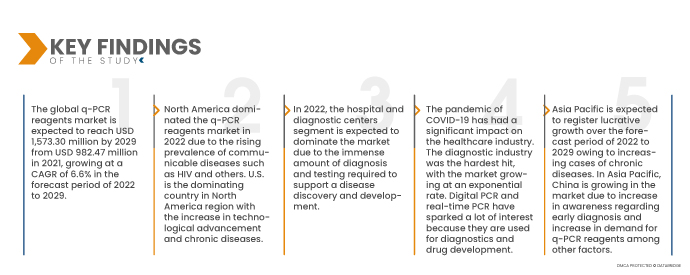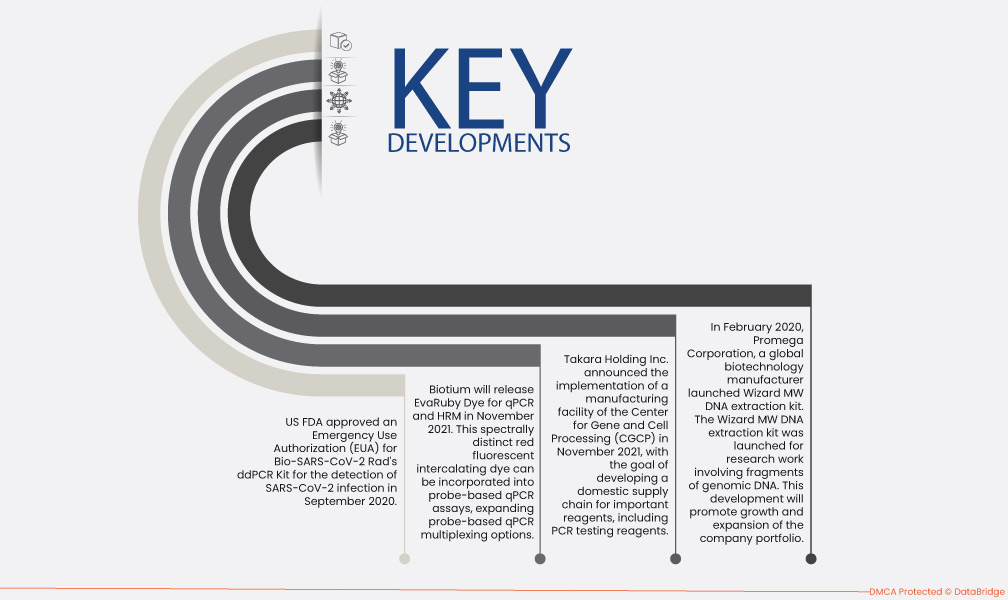تشمل هذه الأمراض أمراض القلب والسرطان والسكري، وهي الأسباب الرئيسية للوفاة والإعاقة في العديد من دول العالم. تُعد كواشف Q-PCR أساسية لتشخيص الأمراض المزمنة مثل فيروس نقص المناعة البشرية (HIV) والملاريا. ولكلا المرضين أعراض غير محددة. تحتوي مجموعات وخلاطات Q-PCR على جميع كواشف PCR اللازمة للكشف السريع والحساس والقابل للتكرار في الوقت الفعلي عن فيروس نقص المناعة البشرية وغيره من الأمراض باستخدام أزواج بادئات عالية التحديد.
يمكنك الوصول إلى التقرير الكامل على https://www.databridgemarketresearch.com/reports/global-q-pcr-reagents-market
من المتوقع أن يصل حجم سوق كواشف تفاعل البوليميراز المتسلسل الكمي العالمي إلى 1,573.30 مليون دولار أمريكي بحلول عام 2029، مقارنةً بـ 982.47 مليون دولار أمريكي في عام 2021، بمعدل نمو سنوي مركب قدره 6.6% خلال الفترة المتوقعة من 2022 إلى 2029. ويساهم ارتفاع موافقات إدارة الغذاء والدواء الأمريكية (FDA) ووجود جهات فاعلة رئيسية في السوق في تعزيز نمو السوق. كما أن الاستثمارات الحكومية المتزايدة، إلى جانب المبادرات الاستراتيجية المتنامية من قبل جهات فاعلة رئيسية في السوق، تتيح للسوق فرصةً لتحسين العلاج. ومع ذلك، فإن تزايد سحب المنتجات يُشكل تحديًا لنمو السوق.
من المتوقع أن يؤدي ارتفاع حالات الأمراض المزمنة على مستوى العالم إلى زيادة معدل نمو السوق
في بيانات مركز السيطرة على الأمراض والوقاية منها (CDC)، وتقرير منظمة الصحة العالمية عن الملاريا في العالم لعام 2020، فإن 50% من سكان العالم معرضون لخطر انتقال الملاريا في 87 دولة ومنطقة. كما تشير البيانات إلى أن الملاريا تسببت في حوالي 229 مليون حالة سريرية. وفي منطقة منظمة الصحة العالمية الأفريقية، تشير التقديرات إلى أن 94% من الوفيات حدثت بسبب الملاريا. ووفقًا لبيانات المسح الوطني للمقابلات الصحية لعام 2018 (NHIS)، في الولايات المتحدة، كان لدى أكثر من نصف (51.8%) البالغين حالة واحدة على الأقل من بين 10 حالات مزمنة تم تشخيصها (التهاب المفاصل والسرطان ومرض الانسداد الرئوي المزمن وأمراض القلب التاجية والربو الحالي والسكري والتهاب الكبد وارتفاع ضغط الدم والسكتة الدماغية وضعف الكلى أو فشلها)، وكان لدى 27.2% من البالغين حالات مزمنة متعددة. وهذا سيؤثر إيجابًا على معدل نمو السوق.
نطاق التقرير وتقسيم السوق
مقياس التقرير
|
تفاصيل
|
فترة التنبؤ
|
من 2022 إلى 2029
|
سنة الأساس
|
2021
|
السنوات التاريخية
|
2020 (قابلة للتخصيص حتى 2014-2019)
|
الوحدات الكمية
|
الإيرادات بالملايين من الدولارات الأمريكية، والحجم بالوحدات، والتسعير بالدولار الأمريكي
|
القطاعات المغطاة
|
نوع الكشف (الكواشف القائمة على الصبغة والكواشف القائمة على المسبار)، نوع التحليل (اختبار/تحليل Q-PCR أحادي المركب واختبار/تحليل Q-PCR متعدد المركب)، التعدد (الكواشف القائمة على الصبغة والكواشف القائمة على المسبار)، نوع التعبئة والتغليف (المجموعات والمزيجات الرئيسية)، التكنولوجيا (التعبير الجيني، تحديد النمط الجيني، تحليل MIRNA، التضخيم المسبق والكشف عن الفيروسات)، التطبيق (التشخيص والبحث والطب الشرعي)، المستخدم النهائي (المستشفيات ومراكز التشخيص، مختبرات الطب الشرعي، المعاهد البحثية والأكاديمية، منظمة البحوث السريرية، وغيرها)، قناة التوزيع (العطاء المباشر، موزعون تابعون لجهات خارجية، وغيرها)
|
الدول المغطاة
|
الولايات المتحدة وكندا والمكسيك في أمريكا الشمالية، ألمانيا، فرنسا، المملكة المتحدة، هولندا، سويسرا، بلجيكا، روسيا، إيطاليا، إسبانيا، تركيا، بقية دول أوروبا في أوروبا، الصين، اليابان، الهند، كوريا الجنوبية، سنغافورة، ماليزيا، أستراليا، تايلاند، إندونيسيا، الفلبين، بقية دول آسيا والمحيط الهادئ (APAC) في منطقة آسيا والمحيط الهادئ (APAC)، المملكة العربية السعودية، الإمارات العربية المتحدة، جنوب أفريقيا، مصر، إسرائيل، بقية دول الشرق الأوسط وأفريقيا (MEA) كجزء من الشرق الأوسط وأفريقيا (MEA)، البرازيل والأرجنتين وبقية دول أمريكا الجنوبية كجزء من أمريكا الجنوبية
|
الجهات الفاعلة في السوق المغطاة
|
Hollister Incorporated (الولايات المتحدة)، وBio-Rad Laboratories, Inc. (الولايات المتحدة)، وAgilent Technologies, Inc. (الولايات المتحدة)، وBiotium (الولايات المتحدة)، وMiRXES Pte Ltd (سنغافورة)، وGeneDireX, Inc. (الولايات المتحدة)، وF. Hoffmann-La Roche Ltd (سويسرا)، وNorgen Biotek Corp (كندا)، وTakara Holdings Inc. (اليابان)، وEnzo Biochem Inc. (الولايات المتحدة)، وQiagen (ألمانيا)، وPCR Biosystems (المملكة المتحدة)، وTonbo Biosciences (الولايات المتحدة)، وQuantabio (الولايات المتحدة)، وMerck KgaA (ألمانيا)، وKaneka Eurogentec SA (اليابان)، وPromega Corporation (الولايات المتحدة)، وSolis BioDyne (إستونيا)، وSeegene Inc. (كوريا الجنوبية)، وSino Biological Inc. (الصين)، وThermo Fisher Scientific Inc. (الولايات المتحدة)، وTRANSGENE BIOTEK LIMITED (الهند)، وNew England Biolabs (الولايات المتحدة)، وEmperical Bioscience, Inc. (الولايات المتحدة)، وYouSeq Ltd (المملكة المتحدة)، و شركة بيونير (كوريا الجنوبية) وغيرها
|
نقاط البيانات التي يغطيها التقرير
|
بالإضافة إلى رؤى السوق مثل القيمة السوقية ومعدل النمو وشرائح السوق والتغطية الجغرافية والجهات الفاعلة في السوق وسيناريو السوق، يتضمن تقرير السوق الذي أعده فريق أبحاث سوق Data Bridge تحليلًا متعمقًا من الخبراء وعلم الأوبئة لدى المرضى وتحليل خط الأنابيب وتحليل التسعير والإطار التنظيمي.
|
تحليل القطاعات:
يتم تقسيم سوق كواشف q-PCR على أساس نوع الكشف ونوع الاختبار ونوع التعقيد ونوع التعبئة والتغليف والتطبيق والتكنولوجيا والمستخدم النهائي وقناة التوزيع.
- بناءً على نوع الكشف، يُقسّم سوق كواشف q-PCR العالمي إلى كواشف قائمة على الصبغة وكواشف قائمة على المسبار. في عام 2022، سيهيمن قطاع الكواشف القائمة على الصبغة على سوق كواشف q-PCR العالمي بحصة سوقية تبلغ 54.93%، نظرًا لمزاياه مقارنةً بالكواشف القائمة على الصبغة، مثل الحصول على نتائج أكثر دقة في وقت أقل من تلك القائمة على الصبغة.
من المتوقع أن تهيمن الكواشف القائمة على المسبار على السوق خلال فترة التنبؤ
الكواشف القائمة على المسبار أكثر دقةً وحساسيةً، وفي كل دورة من تفاعل البوليميراز المتسلسل، تُستخدم الكواشف القائمة على المسبار كمسبار مُحدد للهدف لقياس تضخيم الحمض النووي، مما يُعزز حساسية العينات.
- بناءً على نوع الاختبار، يُقسّم سوق كواشف q-PCR العالمي إلى اختبار/اختبار q-PCR أحادي المركب واختبار/اختبار q-PCR متعدد المركب. في عام 2022، من المتوقع أن يهيمن قطاع اختبار/اختبار q-PCR أحادي المركب على سوق كواشف q-PCR العالمي نظرًا لتزايد الأمراض المزمنة والمعدية.
- بناءً على نوع التعقيد، يُقسّم سوق كواشف q-PCR العالمي إلى كواشف قائمة على الصبغة وكواشف قائمة على المسبار. في عام 2022، من المتوقع أن يهيمن قطاع الكواشف القائمة على الصبغة على سوق كواشف q-PCR العالمي بحصة سوقية تبلغ 54.93%، نظرًا لمزاياه وفوائده مقارنةً بالكواشف الأخرى.
- بناءً على نوع التغليف، يُقسّم سوق كواشف تفاعل البوليميراز المتسلسل الكمي العالمي إلى مجموعات ومزيجات رئيسية. في عام 2022، من المتوقع أن يهيمن قطاع المجموعات على سوق كواشف تفاعل البوليميراز المتسلسل الكمي العالمي بحصة سوقية تبلغ 77.05%، وذلك بفضل سهولة الحصول على المجموعات الأساسية في جميع الدول الرئيسية، وانخفاض أسعارها، وتوسع التمويل الخاص والعام لأبحاث علوم الحياة، والمرونة المُقدمة للمستخدمين النهائيين.
- بناءً على التكنولوجيا، يُقسّم سوق كواشف q-PCR العالمي إلى التعبير الجيني، وتحديد النمط الجيني، وتحليل MIRNA، والتضخيم المسبق، والكشف عن الفيروسات. في عام 2022، من المتوقع أن يهيمن التعبير الجيني على السوق بحصة سوقية تبلغ 38.55% بفضل دقته الموثوقة وكفاءته العالية.
- بناءً على التطبيق، يُقسّم سوق كواشف q-PCR العالمي إلى التشخيص، والبحث، والطب الشرعي. في عام 2022، من المتوقع أن ينمو تطبيق الطب الشرعي في السوق بنسبة 62.20% نتيجةً لتزايد وتيرة القضايا الجنائية، وزيادة أتمتة المختبرات في مختبرات الطب الشرعي.
- بناءً على المستخدم النهائي، يُقسّم سوق كواشف q-PCR العالمي إلى مستشفيات ومراكز تشخيص، ومختبرات الطب الشرعي، ومعاهد بحثية وأكاديمية، ومنظمات أبحاث سريرية، وغيرها. في عام 2022، من المتوقع أن يهيمن قطاع المستشفيات ومراكز التشخيص على السوق بحصة سوقية تبلغ 47.40%، نظرًا للكم الهائل من التشخيصات والفحوصات اللازمة لدعم اكتشاف الأمراض وتطويرها.
من المتوقع أن يهيمن قطاع المستشفيات ومراكز التشخيص على كواشف q-PCR في عام 2022
من المتوقع أن يزدهر قطاع المستشفيات والتشخيص بفضل تزايد عدد مرافق الرعاية الصحية في الاقتصادات النامية. كما أن تزايد أنشطة البحث وتطوير الأدوية سيعزز نمو هذا القطاع.
- بناءً على قنوات التوزيع، يُقسّم سوق كواشف تفاعل البوليميراز المتسلسل الكمي العالمي إلى مناقصة مباشرة، وموزعين تابعين لجهات خارجية، وغيرها. في عام 2022، من المتوقع أن يهيمن نظام المناقصة المباشرة على سوق كواشف تفاعل البوليميراز المتسلسل الكمي العالمي بحصة سوقية تبلغ 56.74%، إذ يُعدّ عملية سهلة لا تتطلب أي وسيلة توريد أخرى.
اللاعبون الرئيسيون
تعترف شركة Data Bridge Market Research بالشركات التالية باعتبارها الجهات الفاعلة في السوق: Hollister Incorporated (الولايات المتحدة)، وBio-Rad Laboratories, Inc. (الولايات المتحدة)، وAgilent Technologies, Inc (الولايات المتحدة)، وBiotium (الولايات المتحدة)، وMiRXES Pte Ltd (سنغافورة)، وGeneDireX, Inc (الولايات المتحدة)، وF. Hoffmann-La Roche Ltd (سويسرا)، وNorgen Biotek Corp (كندا)، وTakara Holdings Inc. (اليابان)، وSeegene Inc. (كوريا الجنوبية)، وSino Biological Inc (الصين)، وThermo Fisher Scientific Inc (الولايات المتحدة)، وTRANSGENE BIOTEK LIMITED (الهند)، وNew England Biolabs (الولايات المتحدة)، وEmpirical Bioscience, Inc. (الولايات المتحدة)، وYouSeq Ltd (المملكة المتحدة)، وBioneer Corporation (كوريا الجنوبية).
تطوير السوق
- وافقت إدارة الغذاء والدواء الأمريكية على ترخيص الاستخدام الطارئ (EUA) لمجموعة ddPCR من Bio-SARS-CoV-2 Rad للكشف عن عدوى SARS-CoV-2 في سبتمبر 2020. وعلاوة على ذلك، أعربت الهيئات التنظيمية عن دعمها القوي للموافقة على هذه الاختبارات من أجل الحد من تأثير تفشي مرض كوفيد-19.
- ستطرح شركة بيوتيوم صبغة إيفا روبي (EvaRuby Dye) لتقنية تفاعل البوليميراز المتسلسل الكمي (qPCR) وتقنية إدارة الهرمونات (HRM) في نوفمبر 2021. يمكن دمج هذه الصبغة الحمراء الفلورية المتداخلة، المتميزة طيفيًا، في اختبارات تفاعل البوليميراز المتسلسل الكمي (qPCR) القائمة على المسبار، مما يوسع خيارات إرسال تعددات تفاعل البوليميراز المتسلسل الكمي القائمة على المسبار. وقد أدى ذلك إلى زيادة محفظة منتجات الشركة.
- أعلنت شركة تاكارا القابضة عن إنشاء منشأة تصنيع في مركز معالجة الجينات والخلايا (CGCP) في نوفمبر 2021، بهدف تطوير سلسلة توريد محلية للكواشف المهمة، بما في ذلك كواشف اختبار تفاعل البوليميراز المتسلسل (PCR). وقد أدى ذلك إلى زيادة إنتاج الشركة ومبيعاتها.
- في فبراير 2020، أطلقت شركة بروميجا، وهي شركة عالمية لتصنيع التكنولوجيا الحيوية، جهاز استخلاص الحمض النووي Wizard MW. صُمم هذا الجهاز لأغراض بحثية تتعلق بأجزاء من الحمض النووي الجينومي. سيعزز هذا التطوير نمو وتوسع محفظة الشركة.
التحليل الإقليمي
جغرافيًا، البلدان التي يغطيها تقرير سوق كواشف q-PCR هي الولايات المتحدة وكندا والمكسيك في أمريكا الشمالية وألمانيا وفرنسا والمملكة المتحدة وهولندا وسويسرا وبلجيكا وروسيا وإيطاليا وإسبانيا وتركيا وبقية أوروبا في أوروبا والصين واليابان والهند وكوريا الجنوبية وسنغافورة وماليزيا وأستراليا وتايلاند وإندونيسيا والفلبين وبقية دول آسيا والمحيط الهادئ (APAC) في منطقة آسيا والمحيط الهادئ (APAC) والمملكة العربية السعودية والإمارات العربية المتحدة وجنوب إفريقيا ومصر وإسرائيل وبقية دول الشرق الأوسط وأفريقيا (MEA) كجزء من الشرق الأوسط وأفريقيا (MEA) والبرازيل والأرجنتين وبقية دول أمريكا الجنوبية كجزء من أمريكا الجنوبية.
وفقًا لتحليل Data Bridge Market Research:
أمريكا الشمالية هي المنطقة المهيمنة في سوق كواشف q-PCR خلال الفترة المتوقعة 2022-2029
تُهيمن أمريكا الشمالية على سوق كواشف تفاعل البوليميراز المتسلسل الكمي (q-PCR) بفضل ارتفاع استثمارات المُصنِّعين الأمريكيين وتزايد انتشار مرض السكري في الولايات المتحدة. وستواصل أمريكا الشمالية هيمنتها على سوق العناية المتقدمة بالجروح من حيث حصتها السوقية وإيراداتها، وستواصل تعزيز هيمنتها خلال فترة التوقعات. ويعود ذلك إلى تزايد اعتماد التكنولوجيا المتقدمة وإطلاق منتجات جديدة في هذه المنطقة. إضافةً إلى ذلك، من المتوقع أن يُعزز تزايد حالات الجروح المزمنة وارتفاع عدد كبار السن معدل نمو السوق في هذه المنطقة.
من المتوقع أن تكون منطقة آسيا والمحيط الهادئ أسرع المناطق نموًا في سوق كواشف q-PCR خلال الفترة المتوقعة 2022-2029
من المتوقع أن تشهد منطقة آسيا والمحيط الهادئ نموًا خلال فترة التوقعات، نظرًا لوجود جهات فاعلة رئيسية في السوق والتطور السريع للمرافق الطبية في الاقتصادات الناشئة في هذه المنطقة. إضافةً إلى ذلك، من المتوقع أن يُسهم ارتفاع الإنفاق على الرعاية الصحية وزيادة دخل الفرد في دفع عجلة نمو السوق في هذه المنطقة.
تحليل تأثير كوفيد-19
كان لجائحة كوفيد-19 تأثير كبير على قطاع الرعاية الصحية. وكان قطاع التشخيص الأكثر تضررًا، حيث شهد السوق نموًا هائلاً. وقد أثار تفاعل البوليميراز المتسلسل الرقمي وتفاعل البوليميراز المتسلسل في الوقت الفعلي اهتمامًا كبيرًا نظرًا لاستخدامهما في التشخيص وتطوير الأدوية. ونتيجة لذلك، يركز موردو الصناعة بشكل متزايد على تطوير مجموعات تفاعل البوليميراز المتسلسل الرقمي بالقطرات للكشف عن كوفيد-19. علاوة على ذلك، قدم العديد من المشاركين في السوق أدوات واختبارات جديدة لاختبار كوفيد-19. على سبيل المثال، وافقت إدارة الغذاء والدواء الأمريكية على ترخيص الاستخدام الطارئ (EUA) لمجموعة ddPCR من Bio-SARS-CoV-2 Rad للكشف عن عدوى SARS-CoV-2 في سبتمبر 2020. علاوة على ذلك، أعربت الهيئات التنظيمية عن دعمها القوي للموافقة على هذه الاختبارات من أجل الحد من تأثير تفشي كوفيد-19. ونتيجة لذلك، سيتم تعزيز نمو السوق.
لمزيد من المعلومات التفصيلية حول تقرير سوق كواشف q-PCR ، انقر هنا - https://www.databridgemarketresearch.com/reports/global-q-pcr-reagents-market












